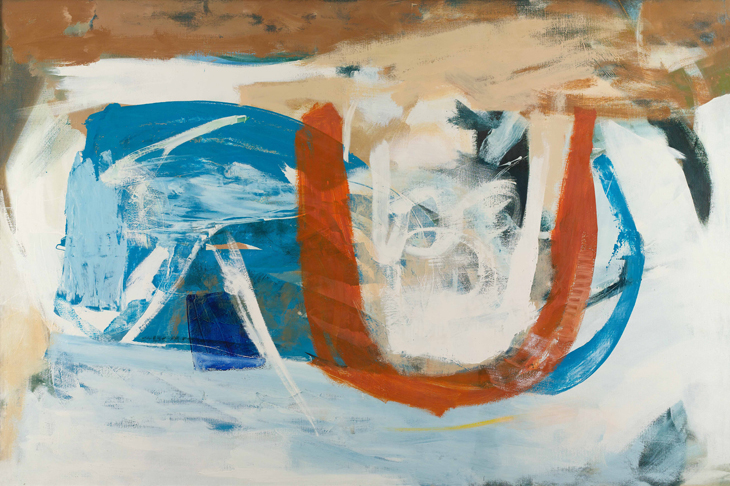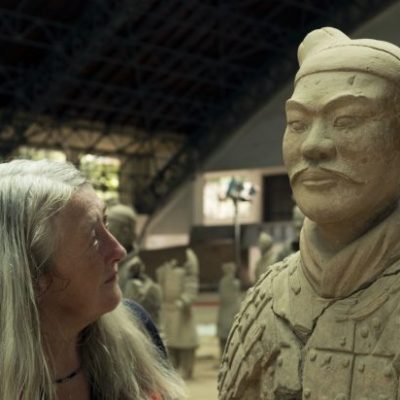In 1954 the artist Peter Lanyon completed Moor Cliff, Kynance, a characteristically lively painting most likely inspired by the landscape of Cornwall’s Kynance Cove. Smooth, muddy patches of paint in the centre give way to a flurry of white and grey spray; a block of dark pigment sits heavy on the lower right of the panel, and another rears up the left edge, topped with grassy green. These abstracted elements are more than enough to give a sense of place, to suggest the cove’s beaches and the rocky outcrops that punctuate it. But there is more to the painting. Lanyon and his wife Sheila went through a crisis in 1954, when he admitted to infidelity shortly after she had given birth to twins. The revelation had led to a serious quarrel by the coast that unsettled him greatly. Moor Cliff was made after that, which may explain its turbulent surface, claustrophobic vertical format, and the fleshy, pinkish section at its centre, with its phallic, visceral associations.
Moor Cliff, Kynance (1954), Peter Lanyon. Arts Council Collection, Southbank Centre, London. © Lanyon Estate

Moor Cliff is one of a selection of Lanyon’s paintings currently on display at Hazlitt Holland-Hibbert in London. Not all of them have such dramatic back-stories, but together they illustrate how tightly Lanyon’s artistic and personal identity was bound up in his experience of place – specifically of Penwith, the westernmost tip of Cornwall where he was born in 1918 and spent most of his life. Over the course of his career Lanyon devised a unique approach to painting that relied on his total immersion within the landscape. He would walk, drive, climb, cycle, swim and eventually glide across and over Cornwall; he learnt the history of its communities; he paid attention to its industries, its prehistoric heritage, the tides and weather fronts and the ever-changing shape of the land itself. Then, he worked out how to pack his paintings with as much of that experience as possible, throwing together multiple perspectives, obscure personal symbols, meaningful colours and expressionist marks. The resulting paintings look improvisational, but they took weeks or months to plan and complete.
Among the highlights in the current display are classics such as Trevalgan (1951; from the David Bowie collection), a self-contained, vibrant green rendition of a Cornish hill; Wheal Owles (1958), an angry work painted in remembrance of a local mining disaster, in which dozens of people died when a mine shaft was breached and flooded; and Loe Bar (1962), a balanced piece that contrasts roiling ocean waves with the still calm of water trapped behind the titular Cornish sand bar. But curator Toby Treves makes a point of trying to expand our view of Lanyon, and on display alongside these Cornish compositions are works the artist painted in and of Italy.
Wheal Owles (1958), Peter Lanyon. © Lanyon Estate/Modern Art Press 2018

Lanyon spent time in Italy during the Second World War and returned there in 1950, ’53 and ’57. The remote hilltop towns of Anticoli Corrado and Saracinesco where he stayed had a tempo and character that reminded him of home, of ‘Cornwall inside out’. These spells away reinvigorated his art, as he adjusted his palette to register the changes in the climate, pace of life, and his own emotions, and grappled with the depiction of a landscape both strange and somehow familiar to him. They also prompted breakthroughs in his Cornish work: it was only on his return from his four-month sojourn in Saracinesco in 1953, for example, that he finally completed his famous painting of St Just, introducing the dark cruciform shaft at its centre that forms a raw tribute to the miners of the town who toiled – and too frequently died – underground.
The real remapping of Lanyon’s oeuvre, however, takes place not in the exhibition but in the new publication that it celebrates. Treves has just released a catalogue raisonné, a decade in the making, which brings together all of Lanyon’s known output. The book makes it possible to contemplate the artist’s most famous paintings alongside all the rest: his early, representational landscapes developed under the tutelage of Borlase Smart; his constructivist experiments inspired by Naum Gabo, Ben Nicholson and Barbara Hepworth, who had resettled in St Ives during the Second World War; his rough and ready sculptures and the dense, dark linocuts he confidently carved from bits of pulled-up flooring. It also reprints dozens of his letters – colourful missives in which he discusses the artists who influenced him, his personal struggles, friendships and feuds, artistic aspirations and developing ideas – complete with doodled illustrations. Seen in its full context, the true complexity of his work becomes apparent. The encircling shape in Trevalgan, it turns out, is inspired not just by the Cornish landmark but by carvings of the Aztec goddess Coatlicue. Saracinesco (1961–62), with is virulent red tones and ebullient splashes of paint, is an evocation of the town’s annual spring festival as well as Lanyon’s own love life (he had visited again with his mistress in 1957, and painted the work after the affair had ended). Motifs which in their first rendition are clearly figurative morph in subtle series of works into bits of landscape and abstract shapes.
Saracinesco (1961), Peter Lanyon. © Lanyon Estate/Modern Art Press 2018

The last major retrospective dedicated to Lanyon was held at Tate St Ives in 2011, and some of his most famous works have been relocated there recently from Tate Britain. Most of the works at Hazlitt Holland-Hibbert have not been seen in London for decades. I hope Treves – who was also behind a popular exhibition of the artist’s gliding paintings at the Courtauld Gallery in 2015 – succeeds in breaking Lanyon’s legacy out of Cornwall. Because in one crucial way the artist’s work is very much like the land that inspired it with its sea caves and mine shafts and ancient stones. The more you dig into it, the more you’re likely to find to surprise you.
‘Peter Lanyon: Cornwall Inside Out’ is at Hazlitt Holland-Hibbert, London, until 16 March.



